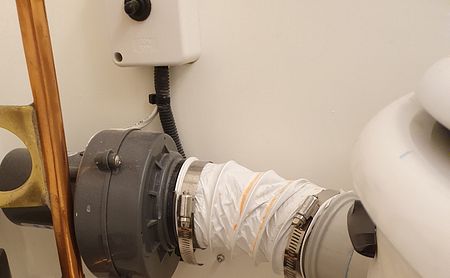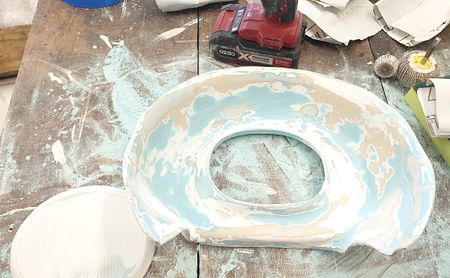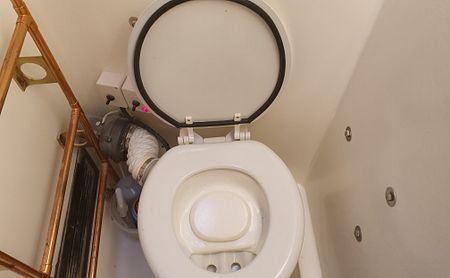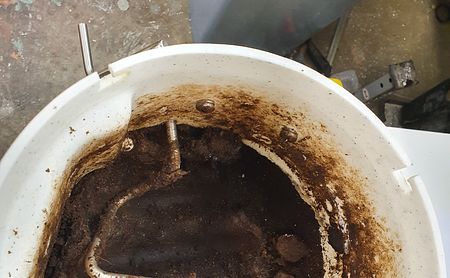There’s been a lot of chat about composting toilets for RVs on the internet, but nobody much with any experience of them here in Australia. We have now been running ours for a couple of months and you may be interested in how well they do or do not work. So why did we fit one to our caravan build?
Without going into too much gory detail, I got rectal cancer about 20 years ago which has left me running to the loo on short notice 4-6 times at all hours of the day and night, worse when things are bad. At that rate a cassette dunny would need emptying probably every day or so, something I wasn’t keen on. The other reason is that the contents of a composting dunny can be bagged up anywhere and disposed of as garbage or simply emptied harmlessly down a long drop loo. The compost itself is not usually smelly at all; but it does contain a lot of pathogenic stuff. Nevertheless, a composting loo was the logical choice for us for bush camping.
Mind you, a “composting” loo does not compost all that much. It does more drying out than it does composting. But after several weeks of not being used, the “compost” in the main bucket does not smell bad; more like a horse stable would smell. Not unpleasant at all, with no trace of toilet paper.
You start off by putting in a standard Bunnings brick of coir and about 3.5 litres of water. You can also add any kind of compost starter if you want to, but the supplier of the loo says that the remnants of a previous fill are enough to start the compost off. I had been using enzyme drain cleaner, but can’t say whether it helped or not and have not used it after the first fill. The coir soon expands and you have a nice fluffy bed of stuff ready to poo into.
So we settled on an Airhead loo which I think cost from memory about $1,650.
http://www.abetterwaytogo.com.au/airheadThe other option was the Nature’s Head, which is pretty much the same design. For that money we expected it to be good. It seems to be well made and was fairly simple to install. Basically it consists of a bucket with a crank handle agitator and a little exhaust fan which keeps it under suction 24-7 and provides fresh air for the compost bed. This makes it absolutely odourless when in use, which makes it great for use in a confined space. The fan draws only a fraction of an amp. I didn’t trust this fan when I was installing the toilet and put a 3 inch bilge blower in series with it. The bigger fan was totally unnecessary.

In front of the compost bucket is a 6 litre bottle which collects urine separately from the solids and loo paper. Getting wee into the compost bed buggers it up with excess nitrogen and makes it go rancid with too much moisture. The design of the toilet bowl is supposed to separate poos from wees. And that’s where the trouble started for us, because it doesn’t.
A wee problem It’s taken as a given that blokes have to sit down to pee with this toilet. And you have to pee straight ahead as you sit or pee straight down. One woman on an international forum was commenting that her husband’s penis was much bigger than normal and folded around in the bowl so that he peed backwards, which buggered the compost. Needless to say, I do not have that problem.
But it seems that ladies often pee in random directions. I didn’t know that and didn’t want to. But after the first week or two of using our composting loo in very cold weather, the thing went all swampy and stank like hell. Adding more coir material and running the big fan helped. But it did not solve the problem. We were in a caravan park and had to march the putrid compost bucket down to the dump point and hose it out; not pleasant.
The supplier says that the wee bucket should last two people several days. It doesn’t. For us, it won’t last two days if you are using it all the time, which means we have to empty it every day. Maybe it’s too much chardonnay. There is a little window on the wee bucket that is supposed to tell you when it’s full; but it’s useless.
To empty the wee pottle, you loosen the wing nuts that hold the compost bucket in place, and the same for the wee bottle. The you tilt the compost bucket back and withdraw the wee bottle, hoping not to spill any. Urine in storage soon stinks like hell. They say you can add a bit of sugar to the wee bucket to stop that, but we found that half a cap of Napisan did the job quite well.
Nevertheless, having to empty the wee bucket every day is a nuisance. But not as big a nuisance as it is if you let it overflow. Then you have to take the whole toilet assembly apart to do a clean up.
Dealing with a crappy issueThe question then arises: how long will it go before you have to empty it? Like all RV toilets, the less you use the composting loo, the better it works. If it sees too much material, toilet paper especially, the bed becomes very dense and the handle gets hard to turn. That’s when it’s time to (a) give it a day of rest and use public loos when you can or (b) check to see that the compost bed has not dried out and add a bit of water, usually a glass full.
Apart from excessive use and drying out in hot weather, there are two other things this composting toilet does not like: cold weather and too much toilet paper.
The second problem is easy to fix. We had to learn to use loo paper very sparingly. We put only heavily soiled toilet paper down the loo and put the rest folded into a plastic bag, which we dispose of every day or two. Wet toilet wipes come in handy as well. The bag never seems to smell. I am down to four squares of Kleenex into the loo per poo and would invite comment from anyone who can get away with less.
Bruce Loxton, before Kimberley Kampers went under, did a lot of good work on composting toilets and penned this very handy manual.
https://www.safiery.com/assets/files/automatic waterless toilet manual 20181123.pdfHe maintained that compost had to get to thirty-something degrees for several hours to kill all the pathogens. He also said that turning the compost frequently and heating the compost was good for speeding things up. He actually fitted his composting toilets with an automated crank and a heating element. It’s a shame his company fell on hard times, because he was one of the industry’s innovators. He was certainly right about turning the compost regularly if only to keep the bottom of the bed from drying out. Every time you pee, turn the handle.
The Human Manure Handbook is very authoritative on the subject of composting toilets, but the author deals with fixed installations that mix wee and poo together in the one bed. He says that, in a cold climate, it tales well over a year for pathogens to be killed. He does not really address the subject of dry composting toilets like we are using in any detail.
So I did three things to try to make our composting toilet a little bit more fit for purpose. I made up a bowl liner insert to direct all of the pee into the pee bottle; I plumbed the pee bottle outside and I rigged up a low voltage heating system.
The bowl insertHere’s a shot of the little bowl insert I made, complete with the removal cover that goes over the top of the poo chute. We formed it by hand from the same thermoplastic that therapists use to make hand splints. That’s another good reason to be married to a physio. It took a fair bit of fairing, sanding and painting to get a slick finish, so that wee would drain away without hanging about.

Here's what the bowl looks like as it comes from the factory, with the chute open.

Here’s what the bowl looks like with the insert in place.

You have to lift the lid off and retract the sliding chute in the bowl to perform a Number Two. This completely fixed the leak you have when you go for a leak and kept all of the urine out of the compost. Blokes can even stand up to pee if their aim is true.
I had a plastics welder put a screwed socket into the side of the urine bottle and then plumbed it via a valve to a tee before the drain on the grey water tank. This means that I can divert the pee to the grey water tank (not a good idea because of the stink) or simply let it drain away onto the ground continually though a 6 metre garden hose with the grey water.
I move the outlet of the hose once or twice every day to spread the joy.
When parked in a public area we keep the pee in the pee bottle and the grey water in the grey water tank until we can empty them. Running the shower and sink water out onto the ground with the pee results in no offensive odours and no visible residues the next day. The sun, the wind and the bare ground seem to deal with it quite well.
The HeaterI found some little 12 volt heating elements online from Core Electronics. They are only a couple of millimetres thick and about half the size of a cigarette packet. Using their data, I figured out that two wired in series would draw one amp and heat up to about 63 degrees at 12.8 volts. We have a big solar system on the Glamper so the current draw was not a problem.
I made up a new base for the toilet out of 25mm low density PVC, with a cut out section underneath the compost container to house some fibreglass and foil insulation and the two heating elements. The new base is glued down to the floor.
Here’s what it looks like.
.jpg?width=450&height=278&fit=bounds&crop=fill)
We run the heaters most of the time in cold weather and it is unnecessary on hot days. If the toilet is not regularly used, especially in hot weather, the stuff at the bottom tends to dry out and go hard, more so if I overdo it with the heating elements. So you have to throw in the odd glass of water when that happens. If you leave it too long in hot weather without adding water, the compost in the bottom of the bucket sets like concrete and the handle gets very hard to turn. When that happens, you have to dig it out with a trowel. It doesn't smell at all and here's what the dried up stuff looks like.

Poo is about 70 per cent water which means the thing can dry out if it is not used. On one occasion, it looked a bit suss and the bed getting too hard to turn, I took the seat assembly off the loo and turned the bed over with a trowel to get things going again. Surprisingly, this was not an altogether unpleasant job.
So where are we now?
We went away for a week, two weeks before Christmas, and the two of us used the loo every day, with occasional breaks using the camp ground loo. Then it sat for two weeks before Christmas, with me adding a small glass of water and turning the bed every day. The volume dropped enormously and no paper was evident. We did not empty it before going away again.
At the time of writing, we have been on the road again for 31 days and have used the toilet almost all of the time. After 18 days away it had not had a break and I thought it might be time to empty it because the handle had got a bit hard to turn. I added some water (to much) to see if it would make the bed a bit crumblier and it did the opposite – turned it all muddy, anaerobic and smelly. So we emptied it in the dump point and refiled with fresh coir, this time with no enzymes.
That’s a total of 25 days without having to empty it. Not bad, for a bloke who visits the loo as often as I do. It’s now been another two weeks since it was last emptied. We have been using the loos in the caravan park for Number Twos for three days and the compost bed looks fine, after adding a glass of water every day during the very hot weather that we've had. The compost bed is currently at 30 degees.
Future mods?The crank handle is poorly designed and does not scour the very bottom of the compost bed. The shape of the compost bucket also means that the compost at each end of the crank doesn’t get turned over. I’ll have to get my thinking cap on about that.
Will report progress on the composting loo over the coming weeks.
But overall, for us this loo seems to be the best choice available.
Happy crapping.
Keith